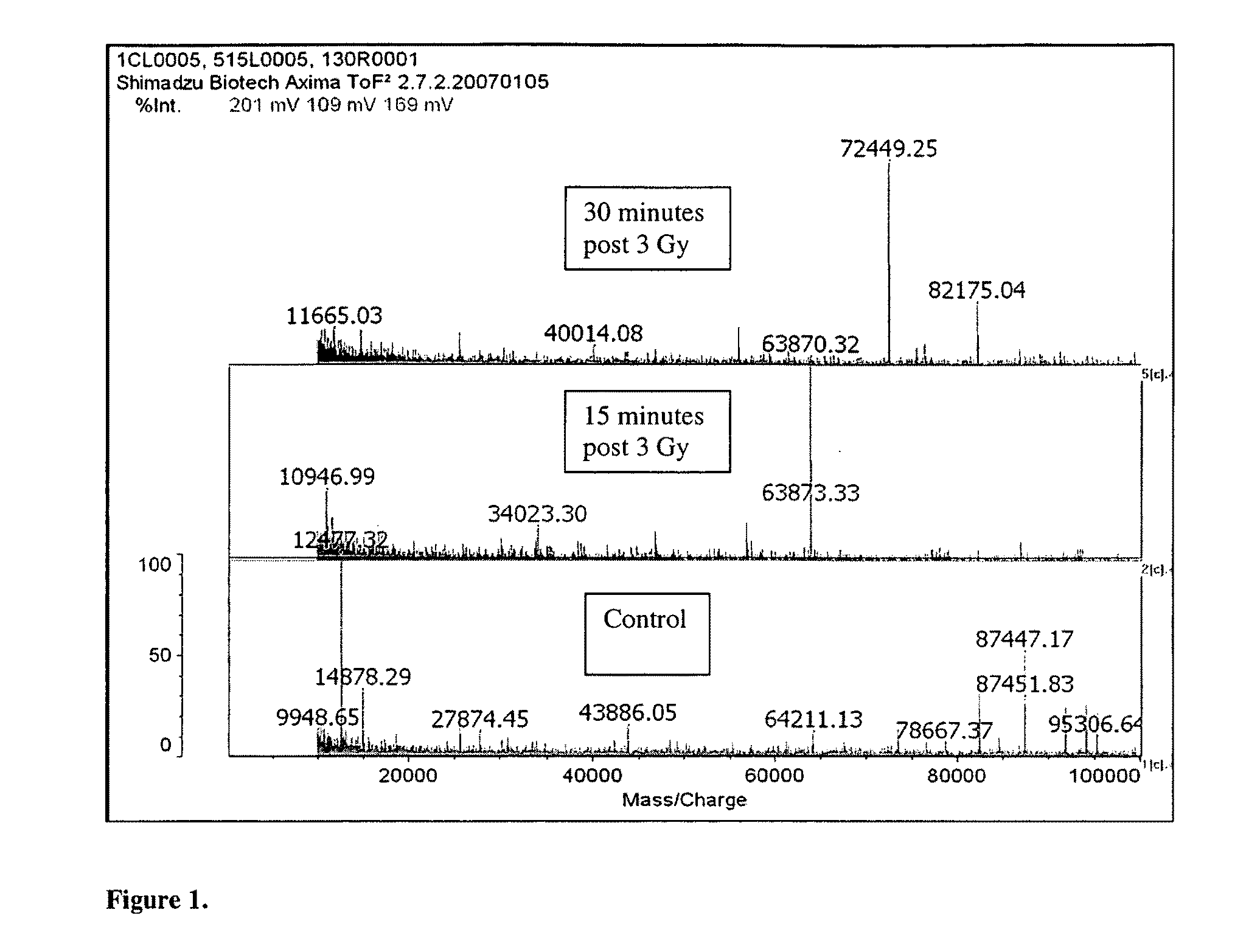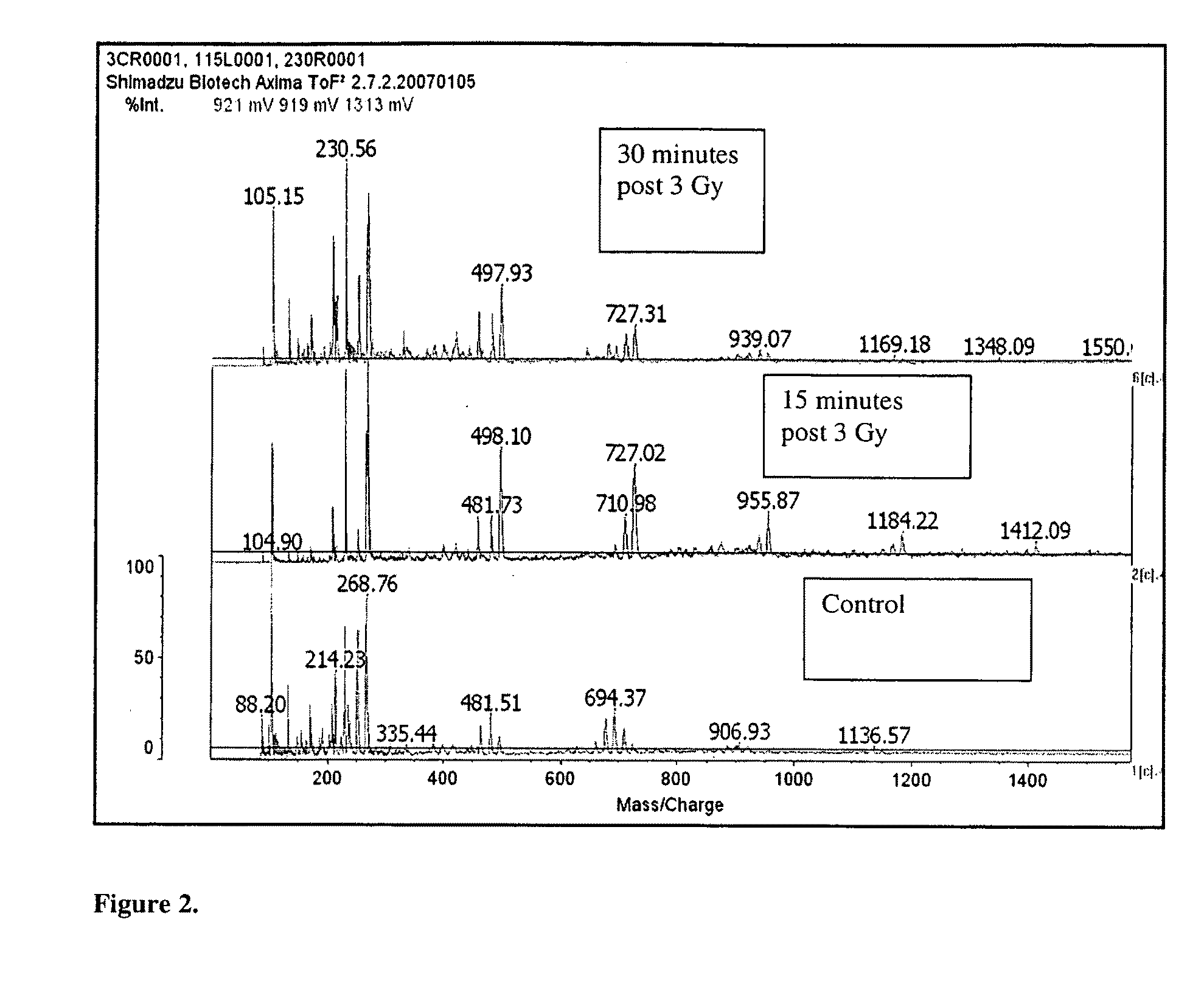Biomarkers of ionizing radiation
a biomarker and radiation technology, applied in the field of new protein biomarkers, to achieve the effect of high throughput, rapid and inexpensive point of care (poc), and high throughpu
- Summary
- Abstract
- Description
- Claims
- Application Information
AI Technical Summary
Benefits of technology
Problems solved by technology
Method used
Image
Examples
example 1
[0072]New protein biomarkers were identified in murine buccal mucosa after ionizing radiation. The new protein biomarkers were identified from scraping of buccal mucosa obtained fifteen and thirty minutes post ionizing radiation exposure. The biomarkers are as follows:[0073]DnaJ homolog subfamily C member 1 (DnaJ protein homolog MTJ1) gi|2494160|sp|Q61712.1|DNJC1_MOUSE[2494160. DnaJ domain. DnaJ domains (J-domains) are associated with hsp70 heat-shock system and it is thought that this domain mediates the interaction which is triggered by ionizing radiation.[0074]mCG1463,isoform CRA_b [Mus musculus][0075]gi|148683958|gb|EDL15905.1|[14868395]. This protein is involved in transcriptional regulation which is triggered by ionizing radiation.
The following three proteins all represent biomarkers of acute radiation exposure which triggers either transcription or post-translational modification.[0076]Novel protein (B230312A22R1k) [Mus musculus] 955.87 Da[0077]Amino Acid Sequence: MSGPRKAPED...
example 2
[0086]Fourteen swiss mice were anesthetized with intraperitoneal ketamine-xylazine (k / x, 80 / 10 mg / kg ip). Ten mice received 3 Gy to the head. Buccal mucosa scrapings were obtained fifteen minutes (5 mice) and thirty minutes (five mice) post exposure. Buccal mucosa scrapings from the four non-radiated mice were used as controls. All reagents were obtained from Sigma (St. Louis, Mo.) and used unmodified. All samples were placed in 1 μL of 100 mMolar ammonium bicarbonate buffer. Proteins were extracted from all the tissues in this buffer with high pressure (Barocycler, Pressure BioSciences, South Easton, Mass.). The samples were concentrated by lypholization to 200 μL and divided into three components. One for trypsin digestion and liquid chromatography mass spectrometry, LCMS, analysis (bottoms-up proteomics), one for HPLC protein separation and FTMS analysis (top-down proteomics) to identify post-translational modifications (this aliquot was frozen for later analysis), and one for di...
example 3
[0089]Additional experiments using total body ionizing radiation (N=21), TBI, exposure at 0 (N=3), 1 (N=6), 2 (N=6), and 3 (N=6) Gy were performed (mice). The murine tongue was chosen for examination. The mice were sacrificed at one hour post TBI. MALDI imaging of tongue tissue was combined with high resolution, 1.43 nm, (IR filter visible light 400 nm, Zeiss 63X oil immersion 1.4 NA objective, and 1.4 NA Olympus condenser) bright field microscopy (the smallest mitochondria are 1000 nm); and liquid chromatography mass spectrometry, LCMS, to obtain protein sequence data for exact identification and localization of post TBI protein biomarkers in the tissue sections. Protein extraction from the 3rd contiguous section was performed with a Barocycler and digested with trypsin for LCMS examination. Contiguous 5μ cryo-sections were obtained for MALDI imaging, examples of normal, post 1, 2, and 3 Gy, FIGS. 5-10; histology (hematoxylin and eosin, H&E), examples of normal, post 1, 2, and 3 Gy...
PUM
| Property | Measurement | Unit |
|---|---|---|
| Volume | aaaaa | aaaaa |
| Time | aaaaa | aaaaa |
| Time | aaaaa | aaaaa |
Abstract
Description
Claims
Application Information
 Login to View More
Login to View More - R&D
- Intellectual Property
- Life Sciences
- Materials
- Tech Scout
- Unparalleled Data Quality
- Higher Quality Content
- 60% Fewer Hallucinations
Browse by: Latest US Patents, China's latest patents, Technical Efficacy Thesaurus, Application Domain, Technology Topic, Popular Technical Reports.
© 2025 PatSnap. All rights reserved.Legal|Privacy policy|Modern Slavery Act Transparency Statement|Sitemap|About US| Contact US: help@patsnap.com



